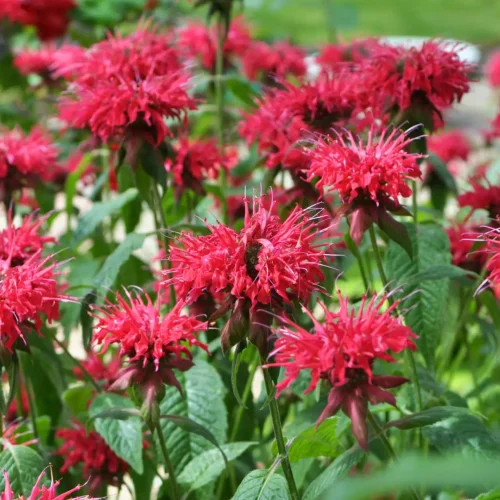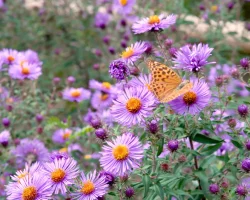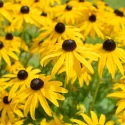Bee balm, monarda, wild bergamot, Oswego tea—these plants go by many common names. All these flowers belong to the Monarda genus, which only includes fifteen species (alongside hundreds of cultivars). The crazy shape of bee balm’s flowers makes them perfect for pollinators—especially hummingbirds. Heights vary, depending on the species, from 2-5 feet. Bee Balm thrives in sun to part sun, making them excellent choices for beginner gardeners. Explore planting tips and varieties below.
Is Bee Balm a good choice for my yard?
Yes, if…
- You want a foolproof, beginner-friendly native plant.
- You want to see hummingbirds and butterflies daily in summer.
- You like fragrant, minty-fresh leaves and colorful blooms.
- You want a perennial that comes back year after year.
- You’d like to try growing from either seed or pass-along plants.
Why Bee Balm matters
- Pollinator favorite: The flower’s tubular petals are tailor-made for hummingbird beaks.
- Easy-care: Once established, rain is usually enough.
- Host plant: Supports native bees and butterflies, while being avoided by deer.
- Historic uses: Nicknamed Oswego Tea after Indigenous and early American use as a tea plant.
Skip pesticides/herbicides—they harm the very pollinators you’re planting Bee Balm to attract.
New to native?
Before lawns and landscaping, native plants were here. They’ve fed birds, bees, and butterflies for thousands of years—and they’ll do the same in your yard. The best part? They’re easier to grow than you think.
Types of native Bee Balm
Meet four native Bee Balm species you’ll find at native nurseries:

Scarlet Bee Balm
Monarda didyma
This classic red-flowered bee balm is native to the Northeast, Midwest, and many Southern states, too. It can be tall—up to 4 feet at its happiest. This is a hummingbird magnet! Bloom time is from June to early August.

Bee Balm / Wild Bergamot
Monarda Fistulosa
This gorgeous light purple bee balm is native to the prairies of the Midwest. It has a lovely smell that is similar to oregano. This is a very resilient, easy-to-grow plant: the Michigan Department of Transportation often plants it along the highways. 3-5 feet tall, June and July bloom-time.

Lemon Bee Balm
Monarda Citriodora
This annual bee balm (it will reseed itself, or need to be reseeded every year after a frost) has a wonderful lemony scent. Its flowers have multiple tiered levels of amazingness. 2-3 feet tall.

Spotted Bee Balm / Horsemint
Monarda punctata
This is our favorite bee balm. Its flowers are tiger-like in their spotted beauty. They smell heavenly in the garden, like a cross between mint and oregano. Depending on where spotted bee balm is planted, it will be an annual (meaning it will only last one season) or a short-lived perennial (coming back for a year or two). It does not like waterlogged soils. 2-3 feet tall.
Explore the full list of 15 Monarda species here
Here are the other species of Monarda native to North America:
5. Monarda clinopodia – White Bergamot
6. Monarda bradburiana – Eastern Bee Balm
7. Monarda media – Purple Bergamot
8. Monarda pectinata – Pony Bee Balm
9. Monarda russeliana – Russell’s Bee Balm
10. Monarda austroappalachiana – Appalachian Bee Balm (new identified species!)
11. Monarda bartlettii – Bartlett’s Bee Balm (native to Mexico)
12. Monarda fruticulosa – Shrubby Bee Balm
13. Monarda clinopodioides – Basil Mountain Mint
14. Monarda viridissima – Green Bee Balm
15. Monarda lindheimeri – Lindenheimer’s Bee Balm
This is a list of the roughly fifteen species within the Monarda genus. I’m saying ‘roughly’ because the number varies between 14-18 depending on the source…and a new species was identified in 2015!
Bee Balm is deer-proof
Deer do NOT eat Bee Balm. If you’re worried about deer nibbling your garden, planting Bee Balm is a good native gardening choice.
Seen other colors with cheeky names like ‘Raspberry Wine’?
Those are cultivar bee balms. You can always identify a cultivar when you see a marketing-friendly name ‘in single quotes.’ There are dozens of cultivar bee balms.
What is a bee balm cultivar?
Cultivars are plants carefully bred or selected by humans. (Here is a beginner-friendly overview of cultivars.) They can be created in many ways, from cutting to more complex processes like intentional cross-pollination or genetic modification by horticulturalists.
Cultivars offer a wide range of drought tolerance, colors, and heights, but some can confuse pollinators (who might not recognize them!) or even have fewer nutrients than their true native parents. Cultivar bee balms include:
- ‘Peter’s Purple’ bee balm, which has a showier, brighter purple bloom
- ‘Raspberry Wine’ bee balm, has a darker red hue
- ‘Bee You Happy’ bee balm is cultivated to be shorter than native versions, so it works well as a border plant
Are bee balm cultivars bad?
The debate around planting native cultivars versus true native species can get pretty intense among gardeners and botanists. Some firmly believe that only true native species—plants naturally found in your region—should be planted. Others, including experts and Master Gardeners at Mt. Cuba Center, the largest native garden in the U.S., welcome cultivars into their landscapes.
Our take: True natives are best for pollinators and genetic diversity, but if a cultivar catches your eye, it’s still better than planting a non-native.
What is a cultivar?
Cultivar is short for CULTIvated VARieties. Cultivars are plants selected for traits like color, size, or disease resistance. Useful and sometimes stunning...but some lose the scent, shape, or timing wildlife depends on. Plant straight species when possible.
How to grow bee balm
Bee balm is one of the easiest native plants to grow, whether you start from seed or get divisions from a neighbor.
From seeds
Bee balm is a great “first seed” for beginners.
- Sprinkle seeds outside in fall or early spring.
- Cover very lightly with soil (just a dusting).
- Let rain do most of the work; water only during long dry spells.
- Thin seedlings in spring if they’re too crowded.
Remember: Native plants plant themselves. You got this.
From plants
- Look locally first: bee balm is often shared for free in gardening groups each spring.
- Choose a spot with well-draining soil and at least 6 hours of sun.
- Prepare by weeding and mixing in compost.
- Dig a hole twice the width of the root ball, set the plant in, and backfill with soil.
- Water deeply the first season to help roots establish; after that, rainfall is usually enough.
Bee balm spreads by rhizomes, which are roots that spread underground. Give it some room, or plan to divide and share plants in future years.
Planting FAQs
Where should I plant bee balm?
Bee Balm is perfect for sunny or part-sunny pollinator gardens. Many Bee Balm species get tall—2-4 feet! Be sure to put shorter native flowers (like Coreopsis) in front of it. Pairing it with other tall flowers—like Rattlesnake Master and Hummingbird Mint—gives lots of look at during the summer.

Does bee balm like sun or shade?
Bee Balm thrives in full sun to part sun. Full shade is the only sun option that won’t work well for Bee Balm. Bee Balm is a great native plant for beginning native gardens since it is happy in many types of light and soil.
What kind of soil does bee balm like?
Bee Balm grows well in soil that’s somewhat moist to average. (Basically, as long as it’s not super dry or water-logged, it will thrive.)
Why does my bee balm have white spots?
Sometimes, especially at the end of the summer, Bee Balm can get white splotches or a white covering over its leaves. This is actually mold, and it tells you that the plant needs more air circulation (basically, it’s crowded.) Dig up the plants near it to give it more air, and voila, the mold issue will be solved.
Bee balm, Oswego tea, monarda…what’s the right name?
These plants go by many names. Over thousands of years, they’ve picked up a pile of nicknames. To keep things simple, we’re calling the whole group bee balm.
But with so many names, how can you be sure you’ve got the right plant?
Botanical Latin to the rescue.
Every bee balm belongs to the genus Monarda. Checking the Latin name is the easiest way to confirm you’re looking at the real thing. Latin names were created so that gardeners and botanists would have a consistent way of identifying plants, regardless of the numerous common names they’ve collected.
Learn more in our quick guide to Latin vs. common names.
Where does the Latin name Monarda come from?
The name Monarda honors Nicolás Monardes, a 16th-century Spanish doctor and botanist. Interestingly, he never set foot in North America, yet his name was given to this beloved group of native plants. Many other North American natives share this pattern, with Latin names tied to European scholars rather than the people and landscapes where the plants evolved. Magnolia and Rudbeckia—aka Black-Eyed Susans—are others.
Bee Balm is related to mint
All bee balms are part of the mint family (Lamiaceae), which explains their fresh, minty-herbal fragrance in the garden. All plants in Lamiaceae have square stems (yep! It’s like tiny, growing Legos). Run your fingers along their stems to spot this cool detail.
Where bee balm shines in your yard
Bee balm is build to shine alongside other natives that bask in full to part sun. Here is some gardening inspiration for placement and pairings:

Where can I find native bee balm?
Thankfully, bee balm is one of the few native plants that are often found in plant nurseries. Here are some recommendations for sourcing native bee balm, either from plants or seed:
Where can I find seeds and plants?
Finding native plants can be challenging (we partly blame Marie Antoinette.) To make it easier, we’ve assembled four sourcing ideas.
300+ native nurseries make finding one a breeze
Explore 100+ native-friendly eCommerce sites
Every state and province has a native plant society; find yours
Online Communities
Local Facebook groups are a great plant source
What to plant with bee balm
Pair bee balm with other flowering native plants that flower throughout the seasons to create a pollinator party. Here are some suggestions:

Pairs well with
Planting native bee balm is an easy way to have a gorgeous garden with way less work than a lawn. Bee balms attract movie star pollinators like hummingbirds and butterflies and are happy in a variety of sun and soil situations. While planting native bee balm varieties is always best for wildlife, cultivar bee balms offer a wide range of heights and colors. Why not start a bee balm collection, and plant a few varieties? Keep exploring native, iconic favorites in our Beginner’s Guide to Coneflowers or our Beginner’s Guide to Milkweed. Or plan a road trip and find your closest native plant nursery. Happy planting!
Sources
- Lady Bird Johnson Wildflower Center, Wild Bergamot
- Lady Bird Johnson Wildflower Center, Lemon Bee Balm
- Lady Bird Johnson Wildflower Center, Scarlet Bee Balm
- Lady Bird Johnson Wildflower Center, Spotted Bee Balm
- Johnson, Lorraine. 100 Easy-to-Grow Native Plants for American Gardens in Temperate Zones. (1999), 20, 124.
- Craigmyle, Marshall. “The Illustrated Encyclopedia of Perennials.” (2002), 193-194.
- Lorimer, Uli. The Northeast Native Plant Primer. (2022), 161-162.
- Taylor, Patricia A. Easy Care Native Plants. (1996), 263-264.
- USGS, Lindenheimer’s Bee Balm
What if your feed was actually good for your mental health?
Give your algorithm a breath of fresh air and follow us.






















